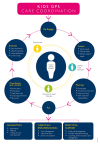"Dealing with the Hospital has Become too Difficult for Us to Do Alone" - Developing an Integrated Care Program for Children with Medical Complexity (CMC)
- PMID: 30245608
- PMCID: PMC6144526
- DOI: 10.5334/ijic.3953
"Dealing with the Hospital has Become too Difficult for Us to Do Alone" - Developing an Integrated Care Program for Children with Medical Complexity (CMC)
Abstract
Introduction: Children with medical complexity (CMC) require highly specialised care, often from multiple providers and over many years. This paper describes the first 18 months of development of the Kids Guided Personalised Services (GPS) Integrated Care Program (the Program). This Program aims to improve health care experience; communication and to streamline provision of care.
Discussion: Key enablers across the Program were put in place and 5 individual project streams were used to implement change. An extensive formative evaluation process was undertaken to truly understand all perspectives in developing the Program.
Conclusion/key lessons: This Program supports families who are caring for CMC by developing shared care models that bring together local health services with the tertiary hospitals. The methodology used has resulted in comprehensive system change and transformation; reduced presentations to the Emergency Department (ED), avoidable admissions and travel time. A challenge remains in meaningfully engaging primary health care providers.
Keywords: Children with medical complexity (CMC); care coordination; paediatric integrated care.
Figures





References
-
- Olsen, L, Saunders, RS and Yong, PL. Owens MK. (2010). Costs of uncoordinated care. Washington DC: National Academy Press In: The healthcare imperative: lowering costs and improving outcomes: workshop series summary, 2010: 109–140. National Academies Press. - PubMed
LinkOut - more resources
Full Text Sources
Other Literature Sources

